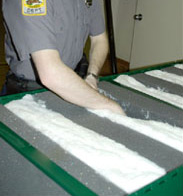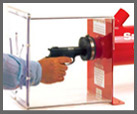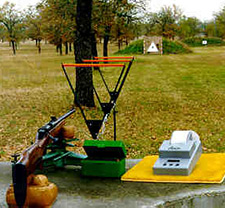Home | Glossary | Resources | Help | Contact Us | Course Map
Archival Notice
This is an archive page that is no longer being updated. It may contain outdated information and links may no longer function as originally intended.
Other Bullet Recovery Systems
Over the years, several alternative techniques have been used for the recovery of fired bullets, including:
- Wet telephone books
- Oil or water-soaked sawdust
- Ballistic gelatin
- Plastic milk jugs
- Blocks of ice
Many of these methods work well because they do not damage the outer surface of fired bullets and prevent fragmentation. However, setup for each test firing is typically time consuming and complex.
In recent decades, variations of the cotton box have been constructed using filler other than cotton, such as rubber balls or foam. These are available in several grades according to the velocity of bullet they are designed to capture.
Outdoor Ranges
In some cases, it may be necessary to use an outdoor firing range, particularly if the indoor range is too short.
Outdoor range facilities may be necessary under the following circumstances:
- Longer distance shot pattern testing.
- Indoor facility construction limits the use of high power ammunition.
- Additional space required to reproduce a shooting scenario.
- Indoor facility construction limits the use of fully automatic firearms.
- Accuracy testing at greater ranges.
Disadvantages of using outdoor ranges not under laboratory control include these:
- Availability and scheduling.
- Permission may be required to conduct testing.
- Adherence to local laws and agency regulations.
- Weather conditions.
Selected Bibliography
- Association of Firearm and Tool Mark Examiners. http://afte.org/
- Biasotti, A.A. 1979. Photomicrography and illumination: some critical factors. AFTE J 11 (4): 60.
- Chamberlain, D. 1972. Microscope comparison bridge. AFTE J 4 (1): 9.
- Cook, C.W. 1985. Basic optics. AFTE J 17 (4): 14.
- Dutton, G. 2004. Firearms identification, comparison microscope & the Spencer Lens Co. AFTE J 34 (2): 186-198.
- Dutton, G. 2004. LEICA FSC Comparison microscope. AFTE J 36 (4): 256-261.
- Forensic Technology WAI Inc. http://www.forensictechnology.com/
- Hatcher, J.S. 1947. Hatchers Notebook . 300-333. Harrisburg: Military Service Publishing Co.
- Haemmerle, C. 1990. Easily made diffusers for fiber optic illuminators. AFTE J 22 (4): 446-447.
- Hueske, E.E. 1990. Preliminary report on the application of fiber optic videomicroscopy to firearm and toolmark examination. AFTE J 22 (3): 280-287.
- Hueske, E.E. 1993. Application of fiber optic videomicroscopy to firearm and toolmark examination: A further look. AFTE J 25 (2): 132-139.
- Lansing, J.F. 1973. Customized comparison microscope. AFTE J 5 (5):25.
- Lutz, M.C. 1986. Evaluation of new fiber optics system. AFTE J 18 (1): 12.
- Martini, L.2005. Adoption of a toolmakers microscope for bullet measurements. AFTE J 37 (3): 194-196.
- Mathews, J.H. 1962. Firearms Identification , Volume I. Springfield: Charles C. Thomas.
- Moran, B. 1997. Building an inexpensive high intensity fluorescent lighting system for the comparison microscope. AFTE J 29 (1): 49-54.
- National Institute of Standards and Technology. http://www.nist.gov/index.html
- Scientific Working Group for Firearms and Toolmarks. http://www.swggun.org/swg/index.php
- Thornton, J. 1989. Some historical notes on the comparison microscope. AFTE J 21 (2): 215-217.
- Wikipedia contributors. Micrometer (device). Wikipedia, The Free Encyclopedia. http://en.wikipedia.org/w/index.php ?title=Micrometer_%28device%29&oldid=165622655
- Ziegler, P.A. 1983. Examination techniques: The beam splitter and reverse lighting. AFTE J 15 (2): 37.
Additional Online Courses
- What Every First Responding Officer Should Know About DNA Evidence
- Collecting DNA Evidence at Property Crime Scenes
- DNA – A Prosecutor’s Practice Notebook
- Crime Scene and DNA Basics
- Laboratory Safety Programs
- DNA Amplification
- Population Genetics and Statistics
- Non-STR DNA Markers: SNPs, Y-STRs, LCN and mtDNA
- Firearms Examiner Training
- Forensic DNA Education for Law Enforcement Decisionmakers
- What Every Investigator and Evidence Technician Should Know About DNA Evidence
- Principles of Forensic DNA for Officers of the Court
- Law 101: Legal Guide for the Forensic Expert
- Laboratory Orientation and Testing of Body Fluids and Tissues
- DNA Extraction and Quantitation
- STR Data Analysis and Interpretation
- Communication Skills, Report Writing, and Courtroom Testimony
- Español for Law Enforcement
- Amplified DNA Product Separation for Forensic Analysts




